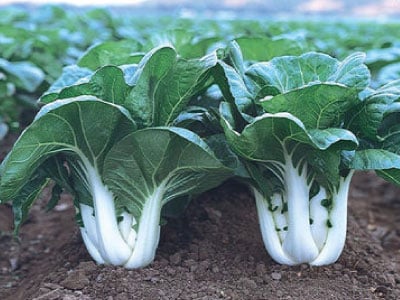
Learning Download: How to Grow Bok Choy
From Seed to Harvest: A beginner’s guide to growing Bok choy.
Bok choy is an excellent, nutrient rich, leafy green to add to your garden. It makes for an interesting incorporation into Asian-style dishes and has a refreshing taste. Bok choy also is known as Chinese cabbage. It is a cool-weather vegetable which grows best in either the spring or the fall, and it’s flavor works in stir-fries, soups and salads.
To plant:
Bok choy can be directly sown into the garden or started indoors to transplant later. Germination will occur in seven to 10 days once planted. If starting indoors, start the seeds before the last frost date in the spring and transplant the seedlings two weeks later. Sow outdoors one to two weeks after the last frost date. Make sure you plant in rich, loose soil. Plant the seeds 1/2 inch deep and 1 inch apart.
If growing for a fall crop, start your bok choy in the late summer time.
To grow:
Once the Bok choy seedlings reach approximately 4 inches tall, thin them to 6 to 10 inches apart. If you are growing more than one row of bok choy, make sure your rows are 18 to 30 inches apart. Make sure the rows stay well weeded so the weeds don’t take nutrients away from the bok choy.
Bok choy can handle full sun, but it grows best in partial shade where it receives three to five hours of sunlight a day. Bok choy will require consistent watering, especially when growing in the fall when the temperatures are slightly higher. Bok choy is typically not affected by diseases, but it can be a victim to pests like cabbage worms. Use row cover to cut down on this problem.
To harvest:
Bok choy only takes 45 days to reach maturity, so you can enjoy your leafy greens relatively quickly after planting them. Harvest the bok choy before the hot weather sets in, because the hot weather will make the bok choy go to seed very fast. Bok choy is ready to harvest when it reaches 12 to 18 inches tall. It doesn’t grow in a head like cabbage does, rather its leaves and stalk grow close together similar to celery. When harvesting, slice the plant about an inch above the ground. This should allow the plants to re-sprout and grow again, albeit much smaller.
What bok choy craves:
Bok choy grows best when fertilized shortly after planting. Use fertilizer high in nitrogen when fertilizing bok choy, but if you’re planting in rich soil, you won’t need to use any fertilizer.
Where to buy bok choy seeds:
you can find a selection of bok choy seeds at Urban Farmer.

